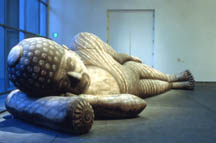 |
| Lewis deSoto, Paranirvana (Self Portrait) 1999, inflated painted cloth, electric fan motor, Courtesy of the artist and Bill Maynes Gallery, New York |
September 1 - November 18, 2001
Over the past two decades, the work of artist Lewis deSoto has been exhibited in museums and galleries throughout the United States as well as in England, Italy, Mexico, Portugal, Spain, and Sweden. Known for public projects and sculptural installations that often incorporate sound, video and theatrical lighting, deSoto brings to his work a strong interest in archaeology, anthropology, sociology, and world religions. This fall the Worcester Art Museum will exhibit his recent sculpture, Paranirvana (self-portrait), in which the artist portrays himself as the reclining Buddha at the moment of death and supreme consciousness. Monumental yet empty, this 25-foot long inflated cloth figure is based on a well-known Buddha at Gal Vihara in Sri Lanka. It is said that Buddha remained on Earth after attaining enlightenment to teach others his insights into achieving salvation. As he lay in pain dying, he gave further compassionate lessons on the nature of consciousness and the structure of samsara (the wheel of life, death, suffering, and rebirth). Although the scale of deSoto's work initially seems, like the issue of death, large and overpowering, the fragile materiality of the work, held up only by the pressure of an air fan, denies this. Picturing his face on the Buddha, deSoto asks himself and the viewer the universal question: How will we face the moment of our death? Born in 1954, Lewis deSoto lives in Napa, California, and is a professor of art at San Francisco State University. He is represented by Bill Maynes Gallery in New York.
Supported by the Don and Mary Melville Contemporary Art Fund.
The media sponsor is Worcester Magazine.

 Sign up for WAM eNews
Sign up for WAM eNews